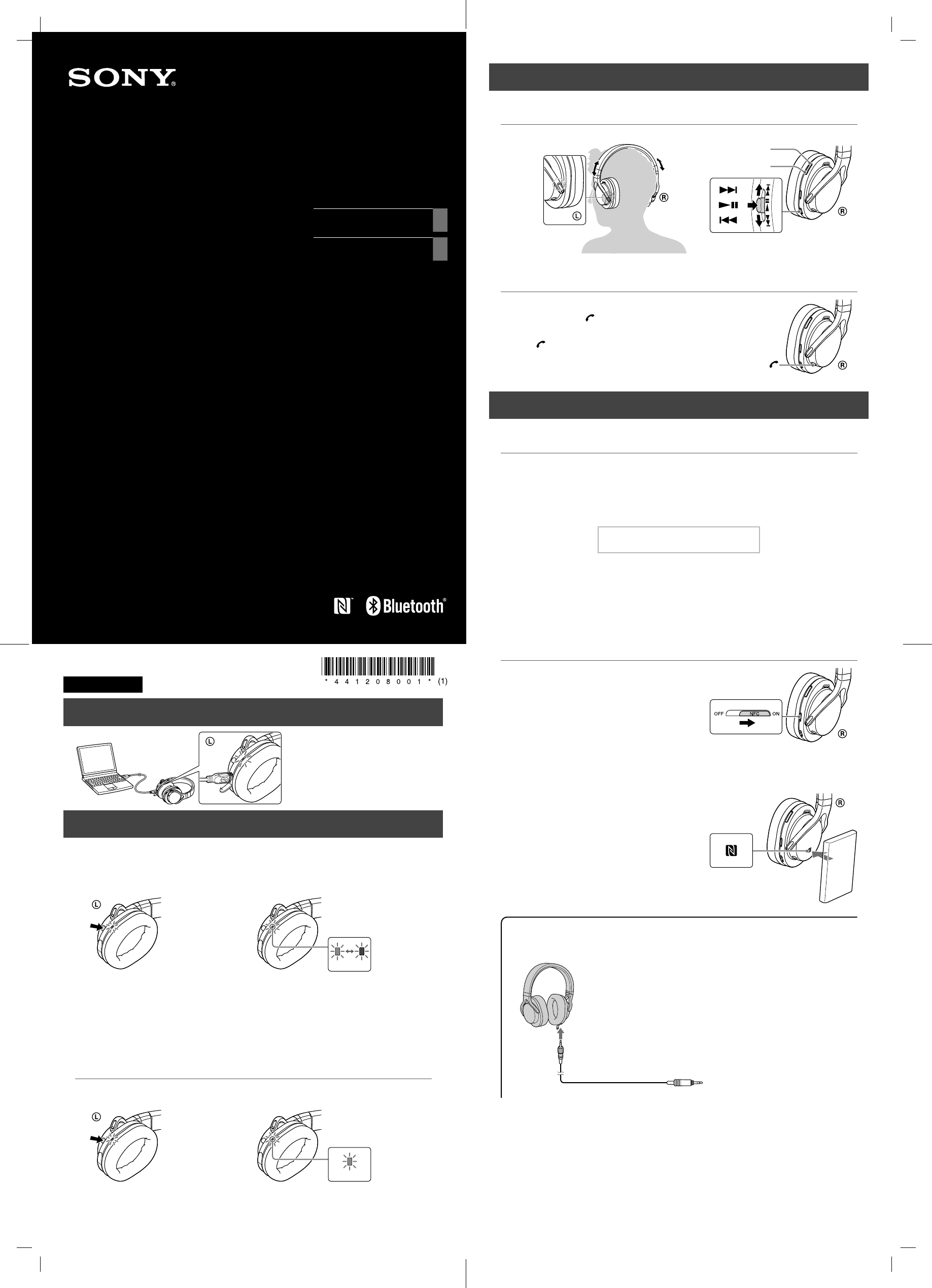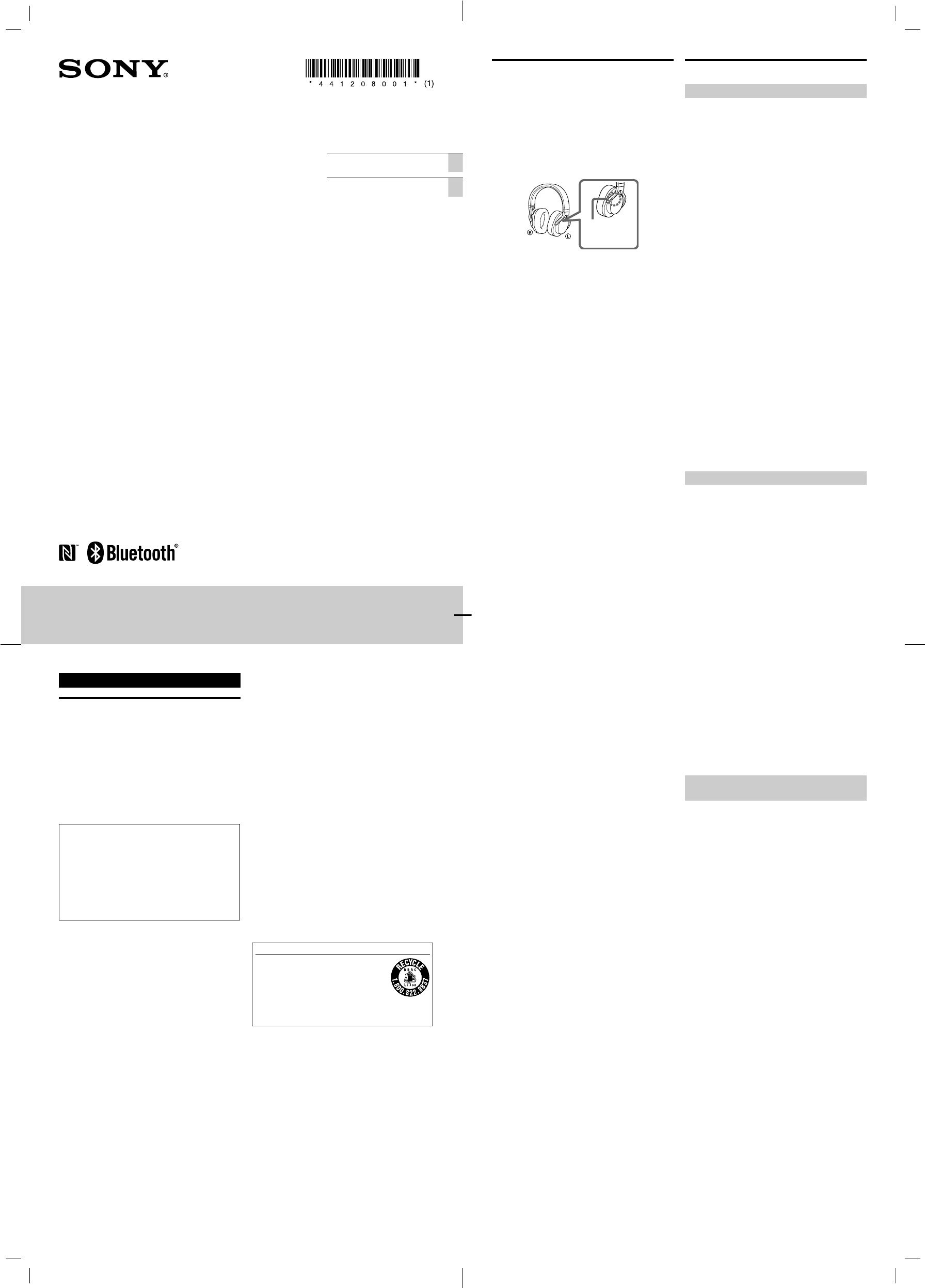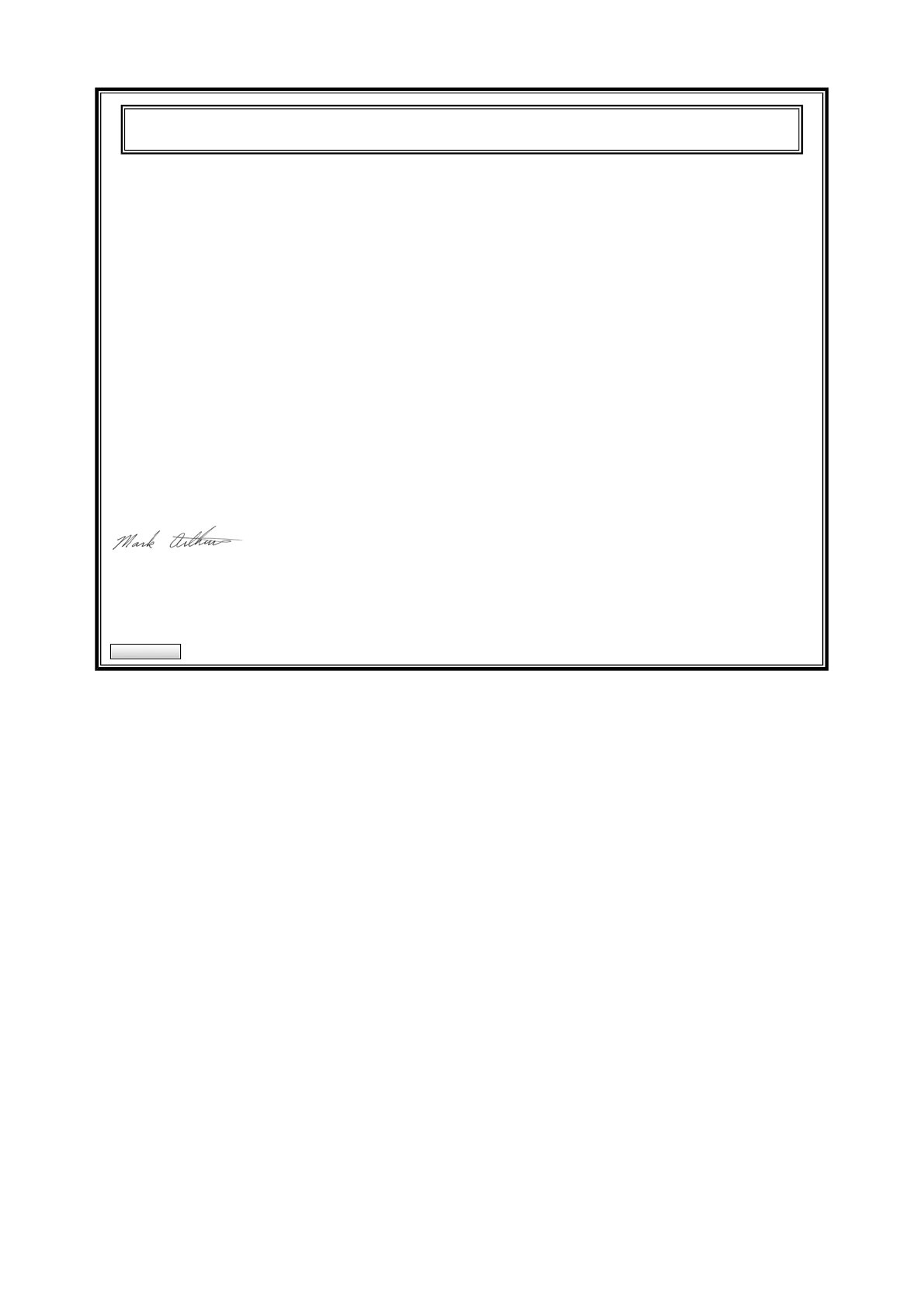Sony Group MDR1RBT Wireless Stereo Headset User Manual MDR 1RBT
Sony Corporation Wireless Stereo Headset MDR 1RBT
Manual

MDR-1RBT 4-xxx-xxx-01(1)
MDR-1RBT
4-xxx-xxx-01(1)
© 2012 Sony Corporation Printed in China
Wireless
Stereo Headset
Quick Start Guide US
Guide de prise en main ES
English
Charging the unit
Charging starts when the unit and the
computer are connected. Charging is
completed in about 6 hours at most and
the indicator (red) goes off automatically.
Pairing and connecting with the Bluetooth device
Before pairing, charge this unit.
1 Place the Bluetooth device within 1 meter (3 feet) of this unit.
2 Enter pairing mode on this unit.
Press and hold the
POWER button for more
than 7 seconds while
this unit is turned off.
Make sure that the indicator
flashes blue and red
alternately after you release
the button.
Blue Red
3 Perform the pairing procedure on the Bluetooth device to detect this unit.
When the list of detected devices appears on the display of the Bluetooth device, select “MDR-1RBT.”
If passkey input is required on the display of a Bluetooth device, input “0000.”
4 Make the Bluetooth connection from the Bluetooth device.
Connecting with the paired device
1 Turn on the unit.
Press and hold the
POWER button for about
2 seconds while this unit
is turned off.
Blue
2 Make the Bluetooth connection from the Bluetooth device.
Listening and Calling
Operate the unit after making Bluetooth connection with your Bluetooth device.
Listening to music
Profile: A2DP, AVRCP
Start playback on the Bluetooth device.
VOL+
VOL−
Making a call/Receiving a call
Profile: HSP, HFP
Operate your mobile phone to make a call.
To terminate a call, press the button on the unit.
Press the button on the unit when an incoming call arrives.
Operate in the same way when an incoming call arrives while you are listening to the
music.
Connecting by using the NFC function
What is the NFC function?
Profile: A2DP, AVRCP
NFC (Near Field Communication) is a technology enabling short-range wireless communication
between various devices, such as mobile phones and IC tags. Thanks to the NFC function, data
communication can be achieved easily just by tapping the relevant symbol or designated location
on NFC compatible devices.
Using the NFC function, you can pair or connect this unit with smartphones easily.
Compatible smartphones
Smartphones with the NFC function built-in
OS: Android 2.3.3 or later
Preparation on the smartphone
An app for the NFC function needs to be installed on the smartphone.
Download the app “NFC Easy Connect” from the Google Play, and install it
1 Download and install the app “NFC Easy Connect.”
2 Set the smartphone so that the NFC function can be used.
For details, refer to the instructions of the smartphone.
Connecting with the smartphone using the NFC function
Pairing and Bluetooth connection can be done by just tapping the unit with the smartphone.
1 Set the NFC switch to ON on this unit.
2 Start the app “NFC Easy Connect” on the smartphone.
Make sure that the application screen is displayed.
3 Tap this unit with the smartphone.
Tap the smartphone on the N marked part of this unit.
Using the unit by connecting the supplied cord
You can use the unit as ordinary wired headphones by connecting the supplied cord.
Supplied cord
The Bluetooth function is disabled.
The Bluetooth word mark and logos are owned by the Bluetooth SIG,
Inc. and any use of such marks by Sony Corporation is under license.
The N Mark is a trademark or registered trademark of NFC Forum, Inc. in
the United States and in other countries.
Other trademarks and trade names are those of their respective owners.

MDR-1RBT [US, ES] x-xxx-xxx-11(1)
MDR-1RBT
©2012 Sony Corporation Printed in China
Wireless
Stereo Headset
Reference Guide US
Reference Guide ES
English
WARNING
To reduce the risk of electrical shock, do not open the
cabinet. Refer servicing to qualified personnel only.
Do not install the appliance in a confined space, such as a bookcase
or built-in cabinet.
Do not expose the batteries (battery pack or batteries installed) to
excessive heat such as sunshine, fire or the like for a long time.
Excessive sound pressure from headphones can cause hearing loss.
Information
If you have any questions about this product, you may call:
Sony Customer Information Service Center 1-800-222-7669 or
http://www.sony.com/
Declaration of Conformity
Trade Name: SONY
Model No.: MDR-1RBT
Responsible Party: Sony Electronics Inc.
Address: 16530 Via Esprillo, San Diego, CA 92127
USA
Telephone No.: 858-942-2230
This device complies with Part 15 of the FCC Rules. Operation is
subject to the following two conditions: (1) this device may not
cause harmful interference, and (2) this device must accept any
interference received, including interference that may cause
undesired operation.
You are cautioned that any changes or modifications not expressly
approved in this manual could void your authority to operate this
equipment.
This equipment must not be co-located or operated in conjunction
with any other antenna or transmitter.
This device complies with Part 15 of the FCC Rules. Operation is
subject to the following two conditions: (1) this device may not
cause harmful interference, and (2) this device must accept any
interference received, including interference that may cause
undesired operation.
This equipment complies with FCC radiation exposure limits set
forth for an uncontrolled environment and meets the FCC radio
frequency (RF) Exposure Guidelines in Supplement C to OET65.
This equipment has very low levels of RF energy that are deemed to
comply without testing of specific absorption ratio (SAR).
Note
This equipment has been tested and found to comply with the
limits for a Class B digital device, pursuant to Part 15 of the FCC
Rules. These limits are designed to provide reasonable protection
against harmful interference in a residential installation. This
equipment generates, uses and can radiate radio frequency energy
and, if not installed and used in accordance with the instructions,
may cause harmful interference to radio communications.
However, there is no guarantee that interference will not occur in a
particular installation. If this equipment does cause harmful
interference to radio or television reception, which can be
determined by turning the equipment off and on, the user is
encouraged to try to correct the interference by one or more of the
following measures:
– Reorient or relocate the receiving antenna.
– Increase the separation between the equipment and receiver.
– Connect the equipment into an outlet on a circuit different from
that to which the receiver is connected.
– Consult the dealer or an experienced radio/TV technician for
help.
The Bluetooth word mark and logos are owned by the Bluetooth
SIG, Inc. and any use of such marks by Sony Corporation is under
license.
The N Mark is a trademark or registered trademark of NFC Forum,
Inc. in the United States and in other countries.
Microsoft, Windows and Windows Vista are registered trademarks
or trademarks of Microsoft Corporation in the United States and/or
other countries.
Macintosh and Mac OS are trademarks of Apple Inc., registered in
the U.S. and other countries.
Other trademarks and trade names are those of their respective
owners.
For the customers in the USA
RECYCLING LITHIUM-ION BATTERIES
Lithium-Ion batteries are recyclable.
You can help preserve our environment by
returning your used rechargeable batteries to the
collection and recycling location nearest you.
For more information regarding recycling of
rechargeable batteries, call toll free
1-800-822-8837, or visit http://www.rbrc.org/
Caution: Do not handle damaged or leaking Lithium-Ion
batteries.
Precautions
On Bluetooth communication
Bluetooth wireless technology operates within a range of about
10 meters (about 30 feet).
Maximum communication range may vary depending on
obstacles (human body, metal, wall, etc.) or electromagnetic
environment.
The antenna is built into the unit as illustrated in the dotted line.
The sensitivity of the Bluetooth communication will improve by
turning the direction of the built-in antenna to the connected
Bluetooth device.
The communication distance shortens when the obstacles are
between the antenna of the connected device and this unit.
Location of
built-in antenna
The following conditions may affect the sensitivity of Bluetooth
communication.
– There is an obstacle such as a human body, metal, or wall
between this unit and Bluetooth device.
– A device using 2.4 GHz frequency, such as a wireless LAN
device, cordless telephone, or microwave oven, is in use near
this unit.
Because Bluetooth devices and wireless LAN (IEEE802.11b/g) use
the same frequency, microwave interference may occur and
resulting in communication speed deterioration, noise, or invalid
connection if this unit is used near a wireless LAN device. In
such a case, perform the following.
– Use this unit at least 10 m (about 30 ft) away from the wireless
LAN device.
– If this unit is used within 10 m (about 30 ft) of a wireless LAN
device, turn off the wireless LAN device.
– Install this unit and Bluetooth device as near to each other as
possible.
Microwaves emitting from a Bluetooth device may affect the
operation of electronic medical devices. Turn off this unit and
other Bluetooth devices in the following locations, as it may cause
an accident:
– where inflammable gas is present, in a hospital, train, airplane,
or a petrol station
– near automatic doors or a fire alarm
This unit supports security capabilities that comply with the
Bluetooth standard to provide a secure connection when the
Bluetooth wireless technology is used, but security may not be
enough depending on the setting. Be careful when
communicating using Bluetooth wireless technology.
We do not take any responsibility for the leakage of information
during Bluetooth communication.
Connection with all Bluetooth devices cannot be guaranteed.
– A device featuring Bluetooth function is required to conform to
the Bluetooth standard specified by Bluetooth SIG, Inc. and be
authenticated.
– Even if the connected device conforms to the above mentioned
Bluetooth standard, some devices may not be connected or
work correctly, depending on the features or specifications of
the device.
– While talking on the phone hands free, noise may occur,
depending on the device or communication environment.
Depending on the device to be connected, it may require some
time to start communication.
Others
Do not place this unit in a place exposed to humidity, dust, soot
or steam, subject to direct sunlight, or in a car waiting at a traffic
signal. It may cause a malfunction.
Using the Bluetooth device may not function on mobile phones,
depending on radio wave conditions and location where the
equipment is being used.
If you experience discomfort after using the Bluetooth device,
stop using the Bluetooth device immediately. Should any problem
persist, consult your nearest Sony dealer.
Listening with this unit at high volume may affect your hearing.
For traffic safety, do not use this unit while driving or cycling.
Do not put weight or pressure on this unit as it may cause the
unit to deform during long storage.
Do not subject the unit to excessive shock.
Clean the unit with a soft dry cloth.
Do not expose the unit to water. The unit is not waterproof.
Remember to follow the precautions below.
– Be careful not to drop the unit into a sink or other container
filled with water.
– Do not use the unit in humid locations or bad weather, such as
in the rain or snow.
– Do not get the unit wet.
If you touch the unit with wet hands, or put the unit in a damp
article of clothing, the unit may get wet and this may cause a
malfunction of the unit.
The earpads may deteriorate due to longterm storage or use.
If you have any questions or problems concerning this unit that
are not covered in this manual, please consult your nearest Sony
dealer.
Specifications
General
Communication System
Bluetooth Specification version 3.0
Output
Bluetooth Specification Power Class 2
Maximum communication range
Line of sight approx. 10 m (30 ft)*1
Frequency band
2.4 GHz band (2.4000 GHz - 2.4835 GHz)
Modulation method
FHSS
Compatible Bluetooth Profiles*2
A2DP (Advanced Audio Distribution Profile)
AVRCP (Audio Video Remote Control Profile)
HFP (Hands-free Profile)
HSP (Headset Profile)
Supported Codec*3
SBC*4 , AAC*5
Supported content protection method
SCMS-T
Transmission range (A2DP)
20 Hz - 20,000 Hz (Sampling frequency 44.1 kHz)
Included items
Wireless stereo headset (1)
Micro USB cable (approx. 50 cm) (1)
Audio cord (approx. 1.5 m) (1)
Carrying pouch (1)
Reference Guide (this sheet) (1)
Recommended accessory
USB Charging AC Power Adaptor: AC-U501AD (sold separately)
*1 The actual range will vary depending on factors such as obstacles
between devices, magnetic fields around a microwave oven,
static electricity, reception sensitivity, antenna’s performance,
operating system, software application, etc.
*2 Bluetooth standard profiles indicate the purpose of Bluetooth
communication between devices.
*3 Codec: Audio signal compression and conversion format
*4 Subband Codec
*5 Advanced Audio Coding
Wireless Stereo Headset
Power source
DC 3.6 V: Built-in lithium-ion rechargeable battery
Mass
Approx. xx g (xx oz)
Operating temperature
0 °C to 45 °C (32 °F to 113 °F)
Usage hours
Communication time (including music playback time):
Approx. 30 hours
Standby time: Max. 200 hours
Charging time
Approx. 6 hours
Receiver
Type
Closed, Dynamic
Driver units
40 mm
Frequency response
4 Hz – 130 kHz
Microphone
Type
Electret condenser
Direction characteristic
Omni directional
Effective frequency range
xx Hz – xx Hz
System requirements for battery
charge using USB
Personal Computer with pre-installed with any of the following
operating systems and USB port:
Operating Systems
(when using Windows)
Windows® 7
Home Basic / Home Premium / Professional / Ultimate
Windows Vista® (Service Pack 2 or later)
Home Basic / Home Premium / Business / Ultimate
Windows® XP (Service Pack 3 or later)
Home Edition / Professional / Media Center Edition 2004 /
Media Center Edition 2005
(when using Macintosh)
Mac OS X (version.10.3 or later)
Design and specifications are subject to change without notice.

MDR-1RBT [US, ES] x-xxx-xxx-11(1)
Español
ADVERTENCIA
Para evitar descargas eléctricas, no abra la unidad. En caso
de avería, solicite los servicios de personal cualificado.
No sitúe el aparato en un espacio cerrado, como una estantería o un
armario empotrado.
No exponga las pilas (la batería o las pilas instaladas) a fuentes de
calor excesivo como luz solar, fuego o similar durante un período
prolongado.
Una presión acústica excesiva de los auriculares puede provocar
pérdidas auditivas.
Información
Se le advierte de que la realización de cambios o modificaciones no
aprobados explícitamente en este manual pueden anular su
autoridad para utilizar este equipo.
El equipo no debe colocarse ni utilizarse junto con ninguna otra
antena o transmisor.
La marca de la palabra Bluetooth y sus logotipos son propiedad de
Bluetooth SIG, Inc. y su uso por parte de Sony Corporation se
realiza bajo licencia.
Microsoft, Windows y Windows Vista son marcas comerciales
registradas o marcas comerciales de Microsoft Corporation en
Estados Unidos y en otros países.
Macintosh y Mac OS son marcas comerciales de Apple Inc.
registradas en Estados Unidos y otros países.
Las demás marcas y nombres comerciales pertenecen a sus
respectivos propietarios.
Para clientes de los EE UU
RECYCLADO DE BATERIAS DE IONES DE LITIO
Las baterías de iones de litio son reciclables.
Usted podrá ayudar a conservar el medio
ambiente devolviendo las baterías usadas al
punto de reciclaje mas cercano.
Para más información sobre el reciclado de
baterías, llame al número gratuito
1-800-822-8837, o visite http://www.rbrc.org/
Precaución: No utilice baterías de iones de litio dañadas o con
fugas.
Precauciones
Comunicación Bluetooth
La tecnología inalámbrica Bluetooth funciona en un rango de
aproximadamente 10 metros.
El rango máximo de comunicación puede variar en función de
los obstáculos (personas, objetos metálicos, paredes, etc.) o del
entorno electromagnético.
La antena está incorporada en la unidad como se muestra con la
línea de puntos. La sensibilidad de la comunicación Bluetooth
mejorará al girar la antena incorporada en la unidad hacia el
dispositivo Bluetooth conectado.
La distancia de comunicación se reduce cuando existen
obstáculos entre la antena del dispositivo conectado y esta
unidad.
Ubicación de la
antena
incorporada
Las condiciones siguientes pueden afectar la sensibilidad de la
comunicación Bluetooth.
– La existencia de obstáculos como, por ejemplo, una persona,
un objeto metálico o una pared entre esta unidad y el
dispositivo Bluetooth.
– El uso de dispositivos que utilicen una frecuencia de 2,4 GHz
como, por ejemplo, un dispositivo LAN inalámbrico, un
teléfono inalámbrico o un microondas cerca de la unidad.
Como los dispositivos Bluetooth y las LAN inalámbricas
(IEEE802.11b/g) utilizan la misma frecuencia, pueden producirse
interferencias de microondas que provoquen el deterioro de la
velocidad de la comunicación, la aparición de ruido o una
conexión no válida si la unidad se utiliza cerca de un dispositivo
LAN inalámbrico. En este caso, realice el procedimiento
siguiente.
– Utilice esta unidad a una distancia mínima de 10 m del
dispositivo LAN inalámbrico.
– Si utiliza esta unidad a menos de 10 m de un dispositivo LAN
inalámbrico, apague el dispositivo LAN inalámbrico.
– Instale esta unidad y el dispositivo Bluetooth a la distancia más
corta posible entre sí.
Las microondas que emite un dispositivo Bluetooth pueden
afectar el funcionamiento de dispositivos médicos electrónicos.
Apague esta unidad y los demás dispositivos Bluetooth en los
lugares siguientes, ya que podrían provocar un accidente:
– donde exista gas inflamable, en un hospital, tren, avión o
gasolinera
– cerca de puertas automáticas o alarmas de incendios
Esta unidad admite capacidades de seguridad que cumplen con el
estándar Bluetooth para proporcionar una conexión segura al
utilizar la tecnología inalámbrica Bluetooth, pero es posible que la
seguridad no sea suficiente según el ajuste. Tenga cuidado al
realizar una comunicación con la tecnología inalámbrica
Bluetooth.
No se aceptan responsabilidades por la pérdida de información
que pudiera producirse durante una comunicación Bluetooth.
No se puede garantizar la conexión con todos los dispositivos
Bluetooth.
– Un dispositivo que disponga de la función Bluetooth debe
cumplir el estándar Bluetooth especificado por Bluetooth SIG,
Inc. y estar autenticado.
– Incluso en el caso de que el dispositivo conectado cumpla el
estándar Bluetooth mencionado anteriormente, es posible que
algunos dispositivos no puedan conectarse o funcionar
correctamente, según las características o las especificaciones
del dispositivo.
– Mientras esté hablando con el manos libre del teléfono, es
posible que se produzca ruido en función del dispositivo o del
entorno de comunicación.
En función del dispositivo que vaya a conectarse, es posible que
transcurra cierto tiempo antes de que se inicie la comunicación.
Otros
No coloque esta unidad en lugares expuestos a humedad, polvo,
hollín, vapor o la luz solar directa, ni la deje en un automóvil en
espera ante una señal de tráfico. Se pueden producir fallas de
funcionamiento.
Es posible que el dispositivo Bluetooth no funcione en teléfonos
celulares dependiendo del estado de las ondas de radio y del lugar
donde se utilice el equipo.
Si no se siente cómodo después de utilizar el dispositivo
Bluetooth, deje de utilizarlo inmediatamente. Si el problema
persiste, consulte con el distribuidor Sony más cercano.
Si usa la unidad a un volumen alto, puede sufrir daños en los
oídos. Por razones de seguridad vial, no la utilice mientras
conduce o va en bicicleta.
No coloque ningún peso ni ejerza presión sobre la unidad, ya que
ésta podría deformarse durante períodos de almacenamiento
prolongado.
No someta la unidad a golpes excesivos.
Limpie la unidad con un paño suave seco.
No exponga la unidad al agua. La unidad no es impermeable.
Recuerde seguir las precauciones siguientes.
– Tenga cuidado de no dejar caer la unidad en un fregadero u
otro recipiente que contenga agua.
– No utilice la unidad en lugares húmedos o si hace mal tiempo,
por ejemplo, si llueve o nieva.
– No deje que la unidad se moje.
Si toca la unidad con las manos mojadas, o la coloca en una
prenda de ropa mojada, la unidad se puede mojar y esto puede
provocar un funcionamiento incorrecto de la misma.
Es posible que los adaptadores se deterioren por el uso o por un
almacenamiento prolongado.
Si desea realizar alguna consulta o solucionar algún problema
relativo a la unidad que no se trate en este manual, póngase en
contacto con el distribuidor Sony más cercano a su domicilio.
Especificaciones
Generales
Sistema de comunicación
Especificación Bluetooth versión 3.0
Salida
Clase de potencia 2 de especificación Bluetooth
Rango de comunicación máximo
Línea de vista de aprox. 10 m*1
Banda de frecuencia
Banda de 2,4 GHz (2,4000 GHz - 2,4835 GHz)
Método de modulación
FHSS
Perfiles Bluetooth compatibles*2
A2DP (Advanced Audio Distribution Profile)
AVRCP (Audio Video Remote Control Profile)
HFP (Hands-free Profile)
HSP (Headset Profile)
Códec compatible*3
SBC*4, AAC*5
Sistema de protección de contenido admitido
SCMS-T
Intervalo de transmisión (A2DP)
20 Hz - 20.000 Hz (frecuencia de muestreo de 44,1 kHz)
Artículos incluidos
Cable USB (1)
xxx (1)
Bolsa de transporte (1)
Manual de instrucciones (este documento) (1)
Accesorio recomendado
Adaptador de alimentación de ca de carga USB:
AC-U501AD (se vende por separado)
*1 El rango real variará en función de factores como, por ejemplo,
los obstáculos que puedan interponerse entre los dispositivos, los
campos magnéticos que puedan existir en torno a hornos
microondas, la electricidad estática, la sensibilidad de recepción
o el rendimiento de la antena, del sistema operativo, de la
aplicación de software, etc.
*2 Los perfiles estándar Bluetooth indican la finalidad de la
comunicación Bluetooth entre dispositivos.
*3 Códec: formato de conversión y compresión de señales de audio
*4 Códec de banda secundaria
*5
Auriculares estéreo inalámbricos
Fuente de alimentación
cc de 3,6 V: batería recargable de iones de litio incorporada
Masa
Aprox. xx g
Temperatura de funcionamiento
De 0 ºC a 45 ºC
Receptor
Tipo
Cerrado, armadura balanceada
Unidades auriculares
Armadura balanceada
Respuesta de frecuencia
4 Hz – 130 kHz
Micrófono
Tipo
MEMS
Características de dirección
Omnidireccional
Gama de frecuencias efectivas
xx Hz – xx Hz
Requisitos del sistema para realizar la
carga de la batería a través de USB
Ordenador con puerto USB y alguno de los siguientes sistemas
operativos instalados previamente:
Sistemas operativos
(con Windows)
Windows® 7
Home Basic / Home Premium / Professional / Ultimate
Windows Vista® (Service Pack 2 o posterior)
Home Basic / Home Premium / Business / Ultimate
Windows® XP (Service Pack 3 o posterior)
Home Edition / Professional / Media Center Edition 2004 / Media
Center Edition 2005
(con Macintosh)
Mac OS X (versión.10.3 o posterior)
El diseño y las especificaciones están sujetos a cambios sin previo
aviso.

Declaration of Conformity
NOT TRANSFERABLE
The company indicated issues this Declaration of Conformity and is solely responsible for the declared
compliance.
This compliance is valid ONLY for the equipment identified when used in a manner with the intent of the
referenced
documents.
Responsible Company: Sony Electronics, Inc.
16530 Via Esprillo
San Diego, CA 92127
Phone: 858-942-2230
Equipment Type & Model: MDR-1RBT
Declared Compliance: This device complies with Part 15 of the FCC Rules. Operation is subject to the
following two conditions: (1) this device may not cause harmful interference and
(2) this device must accept any interference received, including interference that
may cause undesired operation.
08/09/2012
___________________________________ ___________________________________
Date
Mark Arthurs, EMC Site Manager
North America Region Product Compliance Dept.
Customer Satisfaction & Quality, Sony Electronics Inc.
Export PDF
1
/
1ページ
N
orth America Region - Product Compliance
2012/08/10https://inside.am.son
y
.com/secure/service/prodcomp/
g
udoc.do